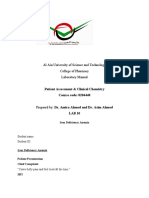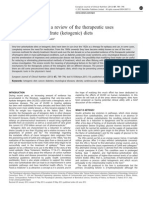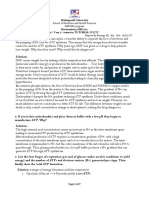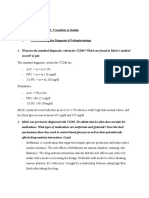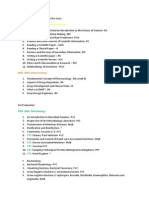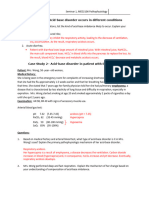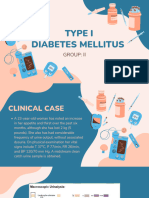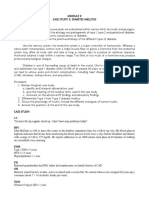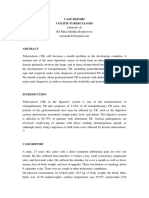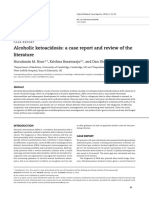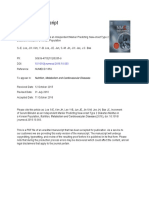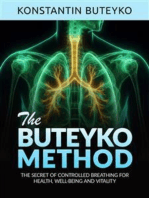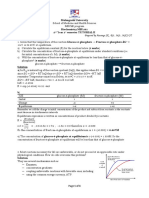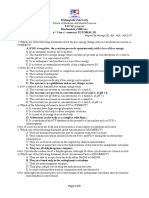0 ratings0% found this document useful (0 votes)
50 viewsDiabetes Tutorial
Conrad, a 13-year-old boy, was brought to the emergency room with increased thirst, urination, nausea, vomiting, abdominal pain, and rapid weight loss. His examination showed mild disorientation, fruity breath, dry mouth, weak and rapid pulse, low blood pressure, and hyperventilation. Laboratory tests found glucose and ketones in his urine, high blood glucose, low pH, high creatinine, and electrolyte imbalances. This is consistent with diabetic ketoacidosis, a life-threatening complication of type 1 diabetes mellitus. The document then asks questions to differentiate type 1 and 2 diabetes, identify signs of diabetes, and discuss short- and long-term complications and risk factors of
Uploaded by
Emmanuel ChendaCopyright
© © All Rights Reserved
Available Formats
Download as PDF, TXT or read online on Scribd
0 ratings0% found this document useful (0 votes)
50 viewsDiabetes Tutorial
Conrad, a 13-year-old boy, was brought to the emergency room with increased thirst, urination, nausea, vomiting, abdominal pain, and rapid weight loss. His examination showed mild disorientation, fruity breath, dry mouth, weak and rapid pulse, low blood pressure, and hyperventilation. Laboratory tests found glucose and ketones in his urine, high blood glucose, low pH, high creatinine, and electrolyte imbalances. This is consistent with diabetic ketoacidosis, a life-threatening complication of type 1 diabetes mellitus. The document then asks questions to differentiate type 1 and 2 diabetes, identify signs of diabetes, and discuss short- and long-term complications and risk factors of
Uploaded by
Emmanuel ChendaCopyright
© © All Rights Reserved
Available Formats
Download as PDF, TXT or read online on Scribd
You are on page 1/ 1
Mulungushi University
School of Medicine and Health Sciences
MBChB program
Biochemistry MBI 261
2nd Year 1st semester DIABETES Tutorial XII
Prepared by Masenga SK., BSc., MSc., PgCert
1. Conrad, a 13 year old was rushed to the LCH casualty. You, the attending doctor
have done history, physical examination and labs. Some findings are shown
below including signs and symptoms:
History: insidious increased thirst and urination, nausea and vomiting with
diffuse abdominal pain, rapid weight loss, Malaise, fatigability,
Examination and vitals: mild disorientation, breath has fruity smell, xerostomia,
weak rapid pulse hyperventilation; BP 70/40,
Laboratory: ketone and glucose are present in urine, glucose-28 mmol/l, HB -
14g/dl, urea – 8.9 mmol/l, creatinine 167 µmol/l, ALT -44 IU, serum Na+
150mmol/l, K+ 5.5 mmol/l, blood pH 6.8
a. What is the diagnosis? 5 marks
b. What is the rationale for the thirst, urination, rapid weight loss, fruity
breath, hyperventilation, hypotension, high creatinine, hyperglycemia,
xerostomia and glucosuria? 20 marks
2. Differentiate diabetes type 1 and 2 – 10 marks
3. What are the classical signs of diabetes mellitus? 3 marks
4. What are the short and long term complications of T2DM – 10 marks
5. What are the risk factors for developing T2DM – 10 marks
Page 1 of 1
You might also like
- Buteyko For The Reversal of Chronic Hyperventilation100% (3)Buteyko For The Reversal of Chronic Hyperventilation8 pages
- Case Study #31: Nutrition Support in Sepsis and Morbid Obesity100% (1)Case Study #31: Nutrition Support in Sepsis and Morbid Obesity24 pages
- Laki-Laki, 21 Tahun Dengan Ketoasidosis DiabetikumNo ratings yetLaki-Laki, 21 Tahun Dengan Ketoasidosis Diabetikum66 pages
- Nephrorounds3 2015final 150907110921 Lva1 App6892 PDFNo ratings yetNephrorounds3 2015final 150907110921 Lva1 App6892 PDF133 pages
- Study of Serum Electrolytes in Acute Exacerbation of Chronic Obstructive Pulmonary Disease PatientsNo ratings yetStudy of Serum Electrolytes in Acute Exacerbation of Chronic Obstructive Pulmonary Disease Patients4 pages
- 2010 - Metabolic Acidosis - Pathophysiology, Diagnosis and ManagementNo ratings yet2010 - Metabolic Acidosis - Pathophysiology, Diagnosis and Management12 pages
- Case Study Presentation: Chronic Obstructive Pulmonary Disease CopdNo ratings yetCase Study Presentation: Chronic Obstructive Pulmonary Disease Copd5 pages
- A Prospective Pilot Study of A Gluten Free Diet For Primary SclerosingNo ratings yetA Prospective Pilot Study of A Gluten Free Diet For Primary Sclerosing13 pages
- Oxidative Stress and Metabolic Disorders - Pathogenesis and Therapeutic Strategies PDFNo ratings yetOxidative Stress and Metabolic Disorders - Pathogenesis and Therapeutic Strategies PDF41 pages
- Beyond Weight Loss: A Review of The Therapeutic Uses of Very-Low-Carbohydrate (Ketogenic) DietsNo ratings yetBeyond Weight Loss: A Review of The Therapeutic Uses of Very-Low-Carbohydrate (Ketogenic) Diets8 pages
- Dietabajaencarbohidratos Moreno Capponi 2020No ratings yetDietabajaencarbohidratos Moreno Capponi 202011 pages
- A Case of Persistent Severe Abdominal Pain Caused by Type 1 Diabetic KetoacidosisNo ratings yetA Case of Persistent Severe Abdominal Pain Caused by Type 1 Diabetic Ketoacidosis3 pages
- Shashank Oxidetive Stress During Dibeties Melletus 2001 (1)No ratings yetShashank Oxidetive Stress During Dibeties Melletus 2001 (1)13 pages
- Unveiling the distinctive gut microbiotaNo ratings yetUnveiling the distinctive gut microbiota3 pages
- Transduksi Sinyal Hormon Kolesistokinin Sebagai TaNo ratings yetTransduksi Sinyal Hormon Kolesistokinin Sebagai Ta11 pages
- Pulmonary Function Tests in Type 2 DiabetesNo ratings yetPulmonary Function Tests in Type 2 Diabetes4 pages
- Seminar 1-Fluid, Electrolytes, Acid-Base Imbalance - With AnswerNo ratings yetSeminar 1-Fluid, Electrolytes, Acid-Base Imbalance - With Answer5 pages
- CMP - Kidney Markers, Hydration Status, and Acid-Base BalanceNo ratings yetCMP - Kidney Markers, Hydration Status, and Acid-Base Balance3 pages
- clinical cases, normal values, inborn errors table mbbs 24No ratings yetclinical cases, normal values, inborn errors table mbbs 2437 pages
- Role of Food and Diet in QOL COPD Fekete 2023No ratings yetRole of Food and Diet in QOL COPD Fekete 202320 pages
- 247 Ketogenic Diet and Its Role in Eliminating PDF100% (1)247 Ketogenic Diet and Its Role in Eliminating PDF14 pages
- SAQ,LAQ OF CHEMISTRY AND METABOLISM OF CARBOHYDRATEsNo ratings yetSAQ,LAQ OF CHEMISTRY AND METABOLISM OF CARBOHYDRATEs1 page
- Accepted Manuscript: 10.1016/j.numecd.2016.10.003No ratings yetAccepted Manuscript: 10.1016/j.numecd.2016.10.00329 pages
- THE BUTEYKO METHOD (Translated): The secret of controlled breathing for health, well-being and vitalityFrom EverandTHE BUTEYKO METHOD (Translated): The secret of controlled breathing for health, well-being and vitalityNo ratings yet




